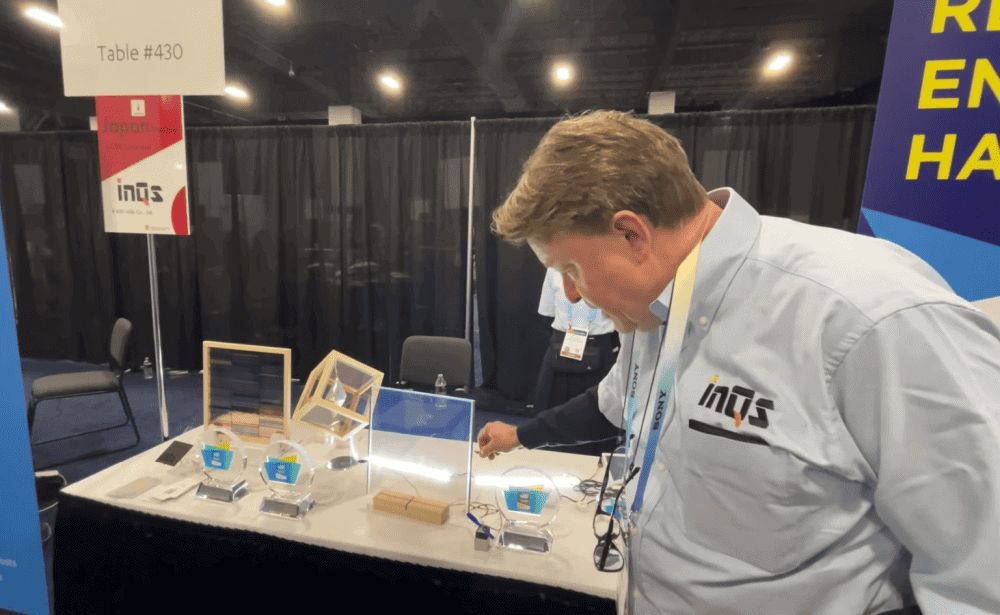
[Image above] Japan-based solar technology company inQs demonstrates their transparent solar technology at CES 2024. Their technology, called SQPV glass, won the show’s Best of Innovation award. Credit: TBW Advisors LLC, YouTube
The year 2022 was an inflection point for solar energy, with rooftop installations growing rapidly in both the commercial and residential sectors. However, current solar panel design limits the options for integrating this technology into buildings.
New materials and design formats for solar cells would provide more opportunities to integrate this technology into the home. Several examples of novel solar solutions were on display at CES 2024.
CES, formerly the Consumer Electronics Show, is said to be the world’s largest annual consumer technology trade show. It takes place each January at the Las Vegas Convention Center in Winchester, Nevada.
This year, CES took place January 9–12 and welcomed more than 135,000 attendees and more than 4,300 exhibitors. During the four-day event, several key announcements were made regarding home solar devices. View the highlights below.
Transparent solar technology wins ‘Best of Innovation’
Silicon solar panels traditionally come in two main formats: polycrystalline (blue) cells, which are less efficient but more affordable; or monocrystalline (black) cells, which are more efficient but less affordable. These cells capture energy mostly from the visible light spectrum (400–700 nm).
In contrast to these opaque cells, transparent solar technologies made from various materials capture energy mostly from the ultraviolet (100–400 nm) and infrared (760+ nm) wavelengths. This absorption spectrum makes transparent solar cells much less efficient than traditional ones. But their transparency opens new opportunities for integrating solar cells into the built environment, for example, as windows, screens, and even smartphone displays.
At CES 2024, the Best of Innovation award went to a transparent solar technology called SQPV glass, which is currently only available in Japan. This technology is based on initial research and patents from Japanese company International Frontier Technology Laboratory Inc., and the company’s subsidiary inQs Co. Ltd. developed it into a commercial product.
The SQPV glass consists of strategically arranged nanomaterials sandwiched between two conductive glass sheets. Light is captured from both glass surfaces while maintaining a visible light transmittance of 75%.
inQs showcased the possibilities for integrating SQPV glass within the home via a stained-glass solar window display at CES 2024. In a CNET article on the invention, inQs chief international officer Rike Wootten notes that the glass is made of “very, very easy to find materials” and can be “easily and safely disposed of,” in contrast to conventional solar panels.

Credit: TBW Advisors LLC, YouTube
Panasonic demonstrates printing of semitransparent perovskite cells
In addition to inQs, Japan-based Panasonic Group also showcased (semi)transparent solar technology at CES 2024 in the form of inkjet-printed perovskite coatings.
As explained in a CNET article, Panasonic’s goal is to directly deposit the perovskite coatings onto windows, walls, and facades, thus turning these surfaces into solar-energy generators. Panasonic can vary the coating’s transparency depending on a customer’s preference for efficiency or see-through ability.
Panasonic is still in the research and development phase of this technology and expects several more years until deployment. However, the company reports that its coatings can already achieve 18.1% conversion efficiency. (NOTE: The video below came out two years ago and thus reports a lower efficiency.)

Credit: Channel Panasonic – Official, YouTube
Ambient Photonics showcases wide array of solar-integrated household products
Solar-powered calculators, originally introduced in the late 1970s, are a prime example of how solar cells can be used to power small household devices. At CES 2024, California-based Ambient Photonics demonstrated the potential to replace batteries with solar in a much wider array of devices.
As described in a CNET article, the Ambient Photonics booth contained keyboards, computer mice, smart home sensors, and other devices featuring its newly improved solar cells. These cells, which are specifically designed for low-light environments, deliver about three times the energy than the cells found in old calculators.
Ambient Photonics’ solar cells come in several sizes, ranging from slightly larger than a thumbnail to about the size of a dollar bill. The cells are not yet available for purchase, but they could be later this year thanks to partnerships with Primax, to develop an ambient solar mouse, and Google, to create a “new consumer product.”

Credit: Ambient Photonics, YouTube
Author
Lisa McDonald
CTT Categories
- Energy
- Material Innovations


